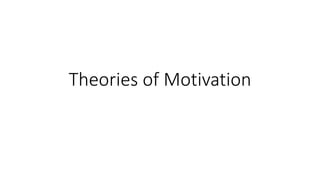
Theories of Motivation lex 4.pptx
- 2. Motivation is the characteristics the helps you achieve your desired goal. Energy that gives you strength to keep going. Motivated person is happy and loyal to his/her work, and that’s what its need to be a successful person.
- 3. Theories of motivation. Content theory 1. Maslow's needs hierarchy 2. Alderfer's ERG theory, 3. McClelland's achievement motivation 4. Herzberg's two-factor theory
- 4. Process theory 1. Adam’s equity theory 2. Goal setting theory
- 5. Maslow's Hierarchy of Needs • Abraham Maslow proposed a hierarchy of needs • It indicates how people in general achieve a sense of satisfaction. • Maslow proposed that needs are satisfied in a certain order • higher-level needs can only be satisfied once lower-level needs are met. • The needs are, from bottom to top of the hierarchy: physiological (the need for food and water), safety and security, social, esteem and status, and the need for self-actualization,
- 6. • The hierarchy is made up of 5 levels: • 1. Physiological – these needs must be met in order for a person to survive, such as food, water and shelter. 2. Safety – including personal and financial security and health and wellbeing. 3. Love/belonging – the need for friendships, relationships and family. 4. Esteem – the need to feel confident and be respected by others. 5. Self-actualization – the desire to achieve everything you possibly can and become the most that you can be.
- 8. Alderfer's ERG Theory • Alderfer’s theory of motivation, sometimes also Three-factor theory or abbreviated ERG (Existence, Relatedness and Growth) is the theories of human motivation. • It's a extension of Maslow's pyramid of needs arranged by the specific needs of the abstract need into three basic levels
- 10. • Existence Needs: The existence needs comprises of all those needs that relate to the physiological and safety aspects of human beings and are a prerequisite for the survival. Thus, both the physiological and safety needs of Maslow are grouped into one category because of their same nature and a similar impact on the behavior of an individual. • Relatedness Needs: The relatedness needs refer to the social needs, that an individual seeks to establish relationships with those for whom he cares. These needs cover the Maslow’s social needs and a part of esteem needs, derived from the relationship with other people.
- 11. • Growth Needs: The growth needs cover Maslow’s self-actualization needs as well as a part of esteem needs which are internal to the individual, such as a feeling of being unique, personnel growth, etc. Thus, growth needs are those needs that influence an individual to explore his maximum potential in the existing environment
- 12. Need for Achievement David McClelland of Harvard proposed the n-ach theory, or the need for achievement, as a way to explain the common tendency of people to seek higher and higher rewards for their actions. It is particularly relevant in the work world. Similar to Maslow's hierarchy, McClelland suggested that people move from lower to higher levels of achievement as they continue to move toward the highest level of achievement.
- 13. Herzberg two factor theory • Frederick Herzberg performed studies to determine which factors in an employee's work environment caused satisfaction or dissatisfaction. He published his findings in the 1959 book The Motivation to Work. • Satisfiers= motivating factors • Dissatisfiers = hygiene factors
- 15. Adams Equity Theory • Adams Equity Theory was developed in 1963. • It suggests that employees become more or less motivated based on the degree to which they believe they are being treated equitably (or fairly) by those around them--particularly their supervisors and managers in workplace settings.
- 16. Input • Effort. • Loyalty. • Commitment. • Skill. • Ability. • Flexibility. • Acceptance of others. • Determination. • Trust in superiors. • Support of colleagues. • Personal sacrifice
- 17. Output • Reputation. • Responsibility. • Sense of achievement. • Praise. • Sense of advancement/growth. • Job security.
- 18. Goal setting theory • In 1960’s, Edwin Locke put forward the Goal-setting theory of motivation. This theory states that goal setting is essentially linked to task performance. It states that specific and challenging goals along with appropriate feedback contribute to higher and better task performance.
- 19. • Specific and clear goals lead to greater output and better performance. Unambiguous, measurable and clear goals accompanied by a deadline for completion avoids misunderstanding. • Goals should be realistic and challenging. This gives an individual a feeling of pride and triumph when he attains them, and sets him up for attainment of next goal. The more challenging the goal, the greater is the reward generally and the more is the passion for achieving it
- 20. • Better and appropriate feedback of results directs the employee behavior and contributes to higher performance than absence of feedback. Feedback is a means of gaining reputation, making clarifications and regulating goal difficulties. It helps employees to work with more involvement and leads to greater job satisfaction.